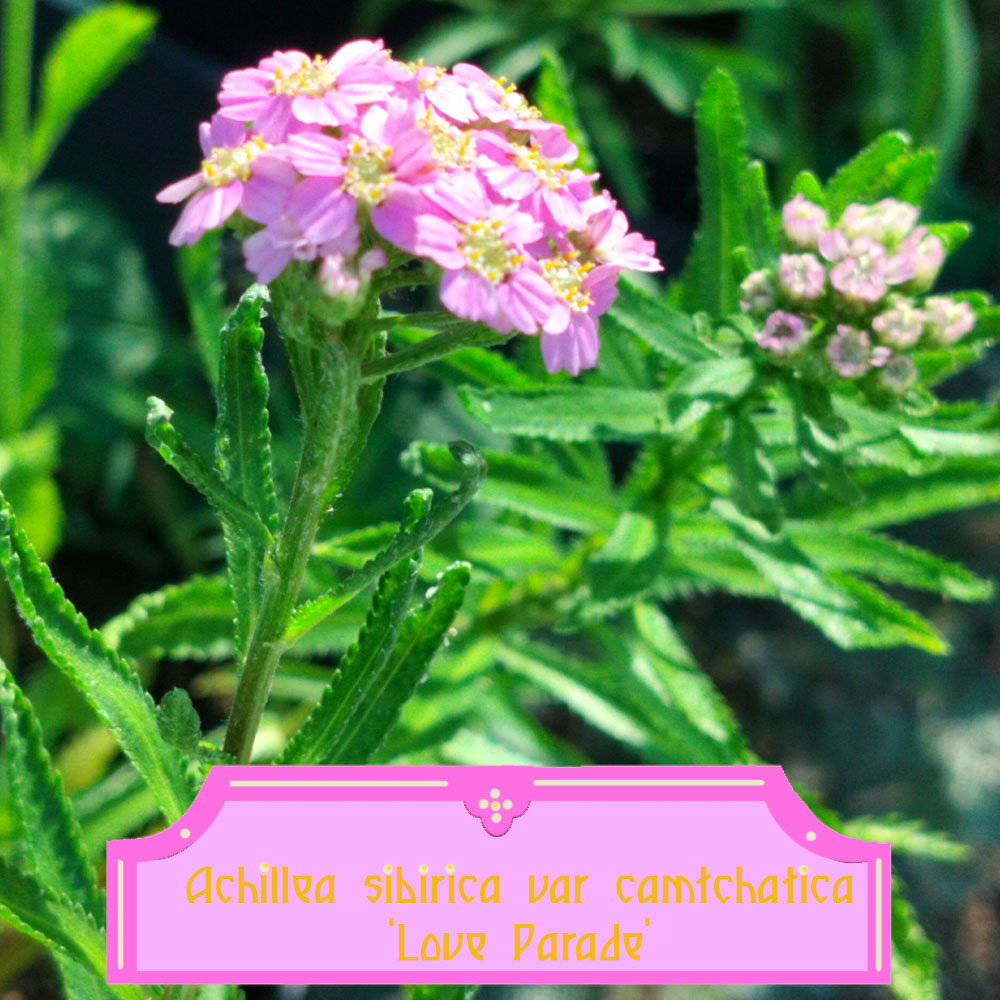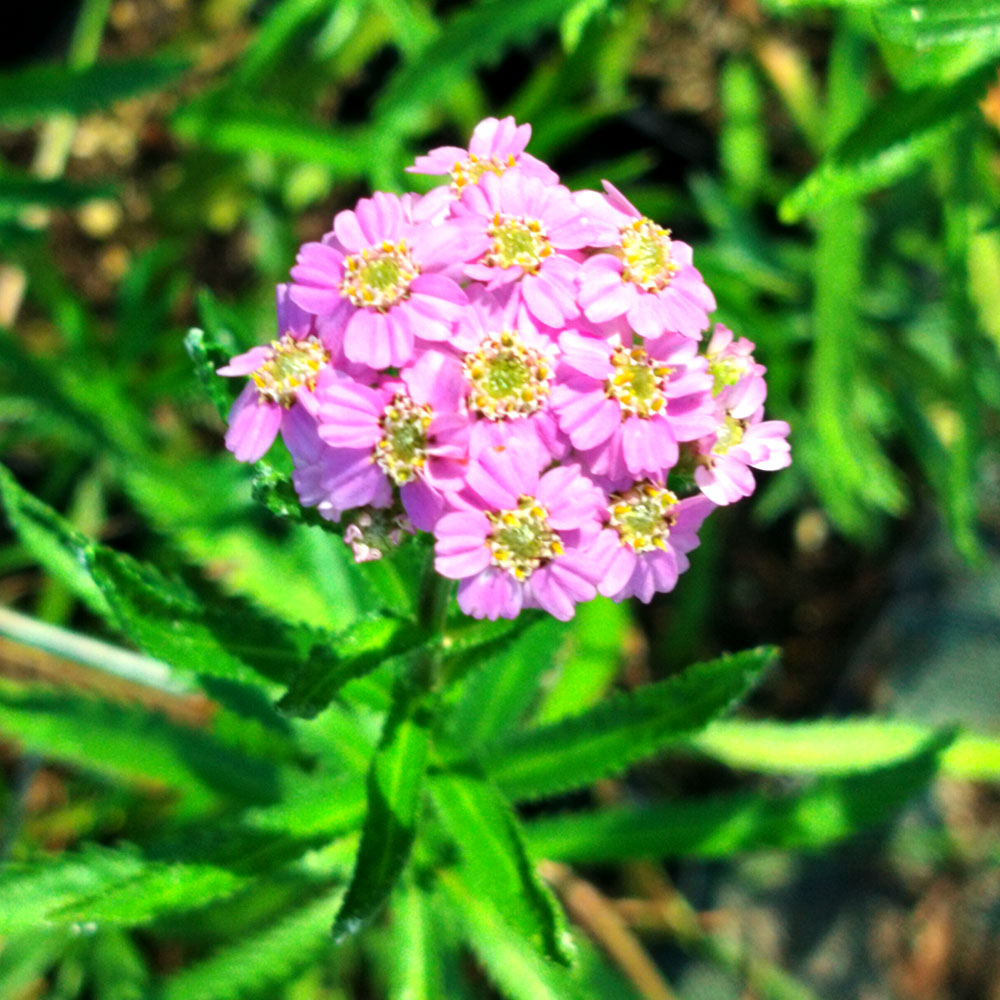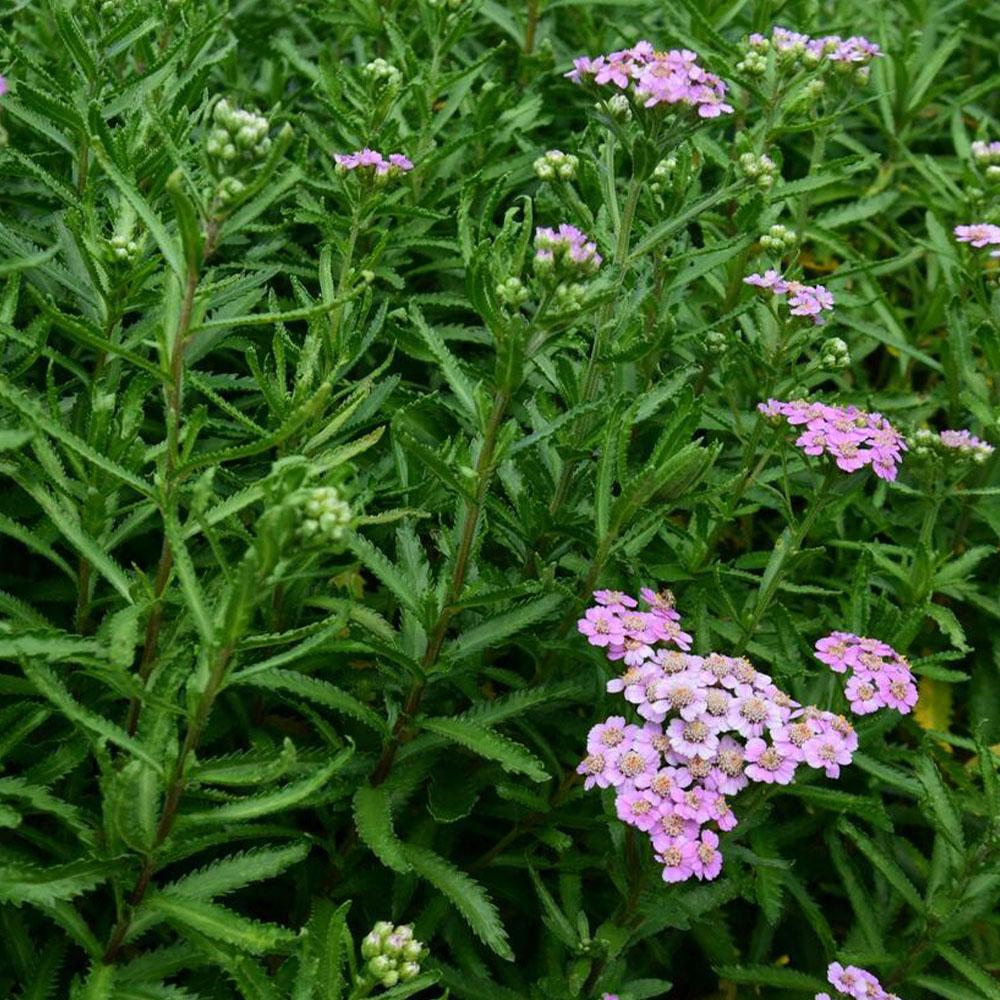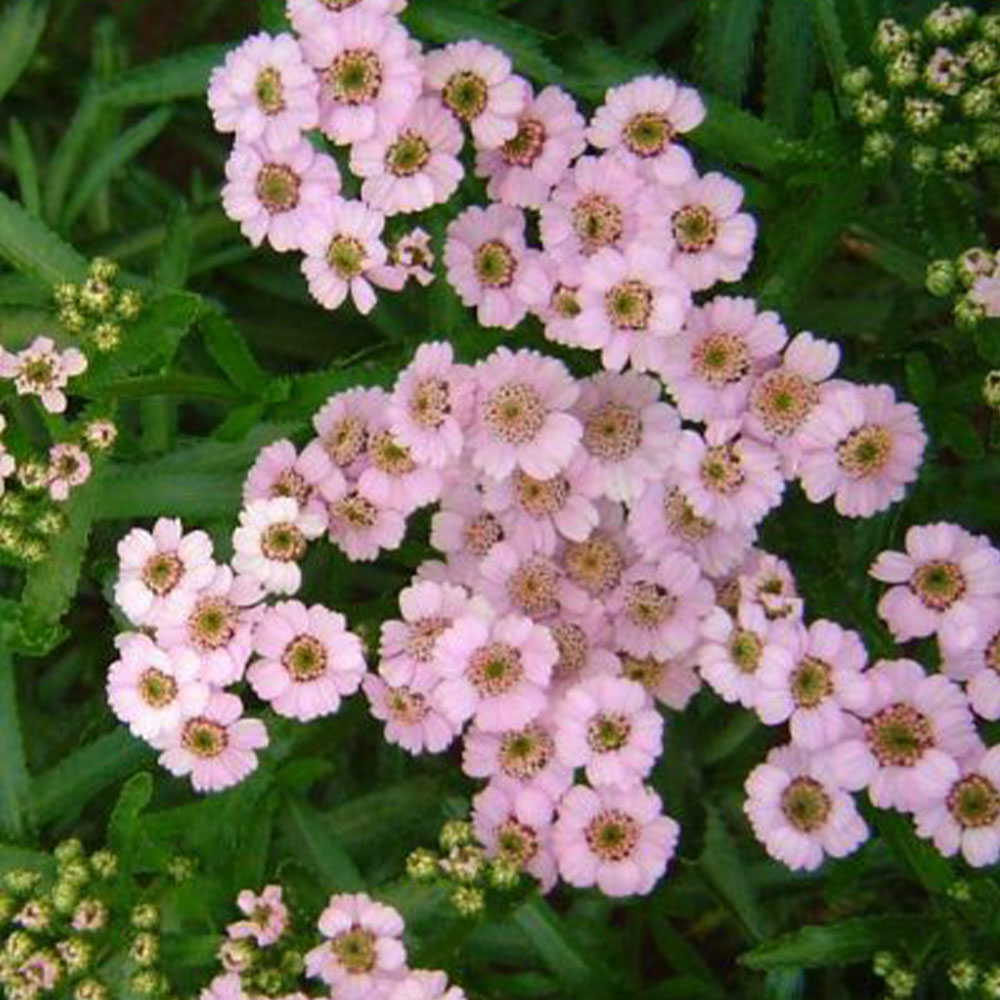No products in the cart.
Achillea sibirica Love Parade
A unique variety with large pink flowers and shiny foliage
Rated 0 out of 5
0 customer reviews
6,50 €
Only 10 item(s) left in stock!
Tags: couleur, evergreen, feuillage persistant, fleurs, graphique, longue floraison, medicinal, perennial, secheresse, vivace
SKU: pda396
Category: Bees and Butterflies, Bouquet, Distillations, Evergreen, Fragrant, Frost Hardy, Ground Cover, Make it Pop, Medicinal, Rewild

Achillea sibirica Love Parade
6,50 €
Only 10 item(s) left in stock!
Achillea sibirica Love Parade [Achillea sibirica var camtschatica Love Parade] is a unique cultivar, compact in shape with large flowers that cover the somewhat unusual shiny leaves.
The foliage is special here – it is long, narrow, leathery, and toothed, with a nearly shiny, almost satin-like appearance.
-
- These leaves are highly unusual for a yarrow and tell their own tale of how to adapt to one of the coldest climates on earth.
The flowers are spectacular, some of the largest in this family – presenting as large umbels of small pale pink flowers with a soft yellow center, which shift to white as the summer fades.
👨🌾GARDENING TIPS👨🌾:
-
- Yarrow is extremely drought- and limestone-tolerant, it really only struggles in heavy, wet soils > keep it well draining!
- Yarrow has a well-developed fibrous root system and prostrate stems that root at the nodes and become far creeping stolons > this means that it can colonize an area quite quickly, creating a beautiful ground cover and interesting alternative lawn choice
-
- The plant has branched rhizomes that generally remain in the top 10 cm of soil > this allows for it to be tamed if ever the colonization is getting out of hand.
- These Crowned yarrows are prized for its drought tolerance, low maintenance, and ability to attract pollinators like bees and butterflies.
- And they look amazing in bouquets or dried flower arrangements.
- Look great with:
- 🔵Blue: Echinops ritro
- ⚪Grey Ladies
Learn more about gardening with this colorful family:
The Tales & The Botany: Achillea sibirica Love Parade
Achillea sibirica Love Parade is particularly, particularly, particularly adapted to cold and frosty climates, hailing as she does from the Northeastern regions of Russia.
It was named after Achilles who used it to bind the wounds of his men at the Battle of Troy as the leaves have astringent properties.
Yarrow has been found with Neanderthal burials, suggesting its association with human species dates to at least 60,000 years ago
It has been used since ancient times to heal wounds and stop bleeding, and in the sixteenth century the crushed leaves were used to stop nosebleeds.
The Miwok in California used the plant as an analgesic and head cold remedy.
The plant contains a uniquely blue essential oil – today it is used widely for medicinal purposes, for happiness creation, for face masks, for hydration, for chasing away sadness… there is lots of research, just make sure to double check the sources!
Yarrow tea has and can be used as a sedative or relaxant to reduce anxiety and stress – it is a bit bitter though, so it isn’t for everyone 🙂
🌸 Floral Morphology: Achillea sibirica Love Parade
The flowers of Achillea sibirica Love Paradeare arranged in flat-topped umbels, forming striking golden clusters at the ends of erect stems.
Each tiny flower is actinomorphic with five petals, and together they create a dense, cloud-like floral display.
The finely divided, fern-like leaves are alternate and aromatic, giving a soft texture that contrasts beautifully with coarser garden plants.
When touched, the foliage emits a mild herbal scent, adding both tactile and olfactory interest to the garden.
🌱 Reproductive Biology
Achillea sibirica Love Parade is hermaphroditic, capable of self-pollination, though cross-pollination by bees, butterflies, and hoverflies is preferred.
Flowering occurs from late spring into midsummer, and deadheading can prolong bloom slightly.
Fruits are small achenes that may self-seed under optimal conditions, allowing the plant to slowly naturalize in sunny, well-drained sites.
The combination of bright flowers and aromatic foliage makes Achillea ‘Coronation Gold’ highly attractive to pollinators, enhancing the ecological value of garden plantings.
🌍 Ecology & Adaptations
Achilléa sibirica Love Parade thrives in temperate and Mediterranean-style gardens, particularly in:
-
- Borders and rockeries: Forms dense mats of aromatic foliage and radiant golden flowers, filling gaps and adding visual interest.
- Pollinator-friendly beds: Flowers provide abundant nectar for bees, butterflies, and hoverflies.
- Sunny, well-drained sites: Full sun encourages prolific flowering and keeps the plant compact, even in poor soils.
Key adaptations include:
-
- 💦 High drought tolerance once established: Hairy, silvery leaves reduce water loss and help the plant survive dry conditions.
- ☀️ Sun-loving: Performs best in full sun but tolerates partial shade.
- 👍 Low-maintenance: Aromatic foliage deters some pests, and the plant requires minimal care.
- 🌸 Long flowering period: Ensures continuous visual impact and nectar supply for several weeks.
- 💪 Self-supporting, compact habit: Ideal for front-of-border planting, rockeries, and container use.
Other Names
Siberian Yarrow
Origin
Northeastern Russia, Kamtchatka
| Weight | 0,5 kg |
|---|---|
| Flower Color | 🩷 Pink |
| Flowering | July, August, September |
| Exposure | Full Sun |
| Frost Tolerance | -20°C to -25°C |
| Size | 0.6m H x 0.6m W |
| Planting Season | March to May, September to November |
Reviews
0
Rated 0 out of 5
0 customer reviews
5
0
4
0
3
0
2
0
1
0
Only logged in customers who have purchased this product may leave a review.
Related Products
Artemisia Valerie Finnis
A semi-evergreen, aromatic variation on the theme of Artemisia.
A semi-evergreen, aromatic variation on the theme of Artemisia.
Rated 0 out of 5
Sedum album
A low, multi-color ground cover.
A low, multi-color ground cover.
Rated 0 out of 5
Glechoma hederacea
A sweet smelling ground cover, producing little blue flowers all summer long.
A sweet smelling ground cover, producing little blue flowers all summer long.
Rated 0 out of 5
Echinacea purpurea
A perennial with purple flowers all summer long
A perennial with purple flowers all summer long
Rated 0 out of 5
Stachys byzantina
Silky white-grey leaves and tall striking flowers
Silky white-grey leaves and tall striking flowers
Rated 0 out of 5
Euphorbia cyparissias Clarice Howard
A Euphorbia that resembles a soft little cyprus tree
A Euphorbia that resembles a soft little cyprus tree
Rated 0 out of 5
Erigeron kavinskianus
A daisy-like carpet of flowers
A daisy-like carpet of flowers
Rated 0 out of 5
Trachelospermum asiaticum ‘Ogon Nishiki’
Jasmine with colorful foliage and lovely white flowers in summer
Jasmine with colorful foliage and lovely white flowers in summer
Rated 0 out of 5
Delosperma cooperi
A dwarf perennial known for its vermillion colored flowers
A dwarf perennial known for its vermillion colored flowers
Rated 0 out of 5
Hieracium maculatum Leopard
A native perennial with blue-green leaves and a tall yellow flower
A native perennial with blue-green leaves and a tall yellow flower
Rated 0 out of 5
Vinca minor
Looping elegance and ability to form a low flowering ground cover
Looping elegance and ability to form a low flowering ground cover
Rated 0 out of 5
Euphorbia myrsinites
Known for its draping form of silver-gray foliage and radiant blooms.
Known for its draping form of silver-gray foliage and radiant blooms.
Rated 0 out of 5
Hellebore argutifolius
Winter flowering perennial with marbled blue-green leaves
Winter flowering perennial with marbled blue-green leaves
Rated 0 out of 5
Cerastium tomentosum var. columnae
A grey-green spreading ground cover from the mountains.
A grey-green spreading ground cover from the mountains.
Rated 0 out of 5
Tradescantia Blushing Bride
Gorgeous blushes of pink and white that appear in the coldest nights.
Gorgeous blushes of pink and white that appear in the coldest nights.
Rated 0 out of 5
Kalanchoe daigremontiana
A toothy succulent from Madagascar, known as the Mother of Thousands.
A toothy succulent from Madagascar, known as the Mother of Thousands.
Rated 0 out of 5
Mentha x piperita ‘Chartreuse’
A spicy mint, known for its use in the production of liqueurs and herbal teas.
A spicy mint, known for its use in the production of liqueurs and herbal teas.
Rated 0 out of 5
Tanacetum densum subsp amani
A shrublet composed of soft, finely divided silvery gray-white leaves.
A shrublet composed of soft, finely divided silvery gray-white leaves.
Rated 0 out of 5
recent view product
Chrysanthemum Mei Kyo
A perennial with pink double pom-pom flowers
A perennial with pink double pom-pom flowers
Rated 0 out of 5
Veronica peduncularis Georgia Blue
A gorgeous creeping perennial that creates a dense carpet of bright blue flowers.
A gorgeous creeping perennial that creates a dense carpet of bright blue flowers.
Rated 0 out of 5
Origanum vulgare Variegatum
A dense carpet of green and cream fragrant leaves
A dense carpet of green and cream fragrant leaves
Rated 0 out of 5
Campanula porscharskyana Lisduggan Variety
A lovely wild ground cover with star shaped lavender flowers
A lovely wild ground cover with star shaped lavender flowers
Rated 0 out of 5
Ballota pseudodictamnus
An unusually soft, grey flowering plant from the mint family.
An unusually soft, grey flowering plant from the mint family.
Rated 0 out of 5


















































There are no reviews yet.